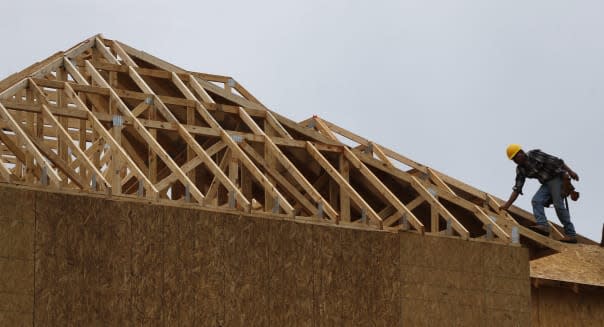Demand for Rental Apartments Buoys Housing Starts

By Lucia Mutikani
WASHINGTON -- U.S. housing starts rose solidly in September on soaring demand for rental apartments, a sign that the housing market continues to steadily improve even as economic growth has slowed.
The Commerce Department said Tuesday groundbreaking increased 6.5 percent to a seasonally adjusted annual pace of 1.21 million units. It was the sixth straight month that starts were above 1 million units, suggesting a sustainable housing recovery that could shield the economy against global headwinds.
%VIRTUAL-pullquote-The report provides further confirmation that the U.S. housing recovery remains on track...%"The report provides further confirmation that the U.S. housing recovery remains on track, and the buoyancy in the housing sector is likely to remain an important source of support for household confidence and economic activity more generally," said Millan Mulraine, deputy chief economist at TD Securities in New York.
Housing is one of the few bright spots in the economy, which has been slammed by softening global demand and a strong dollar, which have undercut exports. Efforts by businesses to reduce an inventory bulge and weak capital spending in the energy sector have also been a drag.
Economic activity has braked sharply, with third-quarter growth estimates running below a 1.5 percent annualized rate. The economy grew at a 3.9 percent rate in the second quarter.
Although residential construction accounts for a fraction of gross domestic product, housing has a broader impact on the economy, with rising home prices boosting household wealth and therefore supporting consumer spending.
Economists say strong domestic demand and firming housing strengthen the argument for the Federal Reserve to raise interest rates this year.
"But the Fed seems to be using binoculars to look at the economy, as it is the rest of the world, not domestic demand, that seems to be the focus of attention," said Joel Naroff, chief economist at Naroff Economic Advisors in Holland, Pennsylvania.
"The U.S. economy may not be booming, but it is in pretty decent shape," he added.
Economists had forecast groundbreaking on new homes rising to a 1.15 million-unit pace last month.
The S&P homebuilding index rose more than 2 percent, outperforming a marginally weaker stock market. D.R. Horton (DHI), the largest U.S. homebuilder, gained 1.78 percent. Lennar (LEN), the nation's second-largest homebuilder, advanced 2.5 percent.
The dollar slipped against a basket of currencies and prices for Treasury debt fell.
Renting in Vogue
Starts for multifamily projects surged 18.3 percent to a 466,000 unit pace, the highest level since June. Multifamily construction is being driven by demand for rentals, especially by millennials, who cannot afford to buy their own homes because of higher prices and debt burdens.
Groundbreaking for single-family homes, the largest segment of the market, rose 0.3 percent to a 740,000 unit pace. Economists say single-family building is being constrained by land and labor shortages.
%VIRTUAL-WSSCourseInline-750%"The continued demand for rentals, as well as the tight supply in the single-family home market, is expected to keep housing construction rising," said David Nice, an economist at Mesirow Financial in Chicago.
Starts in the South, where most of the home construction takes place, rose 0.6 percent to their highest level since October 2007. Groundbreaking on housing projects in the West was the highest since July 2007.
Though building permits fell 5 percent to a 1.10 million-unit rate last month, a six-month low, the weakness is likely to be temporary amid strong confidence levels among homebuilders.
A survey Monday showed builders' confidence rose to a near 10-year high in October, with builders upbeat about current sales conditions and expectations over the next six months.
Single-family building permits slipped 0.3 percent last month. Multifamily building permits dropped 12.1 percent, with permits for buildings with five units or more falling to their lowest level in nine months.
Permits for single-family homes in the South rose to their highest level since January 2008.
